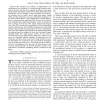Free Online Productivity Tools
i2Speak
i2Symbol
i2OCR
iTex2Img
iWeb2Print
iWeb2Shot
i2Type
iPdf2Split
iPdf2Merge
i2Bopomofo
i2Arabic
i2Style
i2Image
i2PDF
iLatex2Rtf
Sci2ools
TCOM
2008
2008
Differentiated rate scheduling for the down-link of cellular systems
We consider the problem of differentiated rate scheduling for the downlink (i.e., multi-antenna broadcast channel), in the sense that the rates required by different users must satisfy certain constraints on their ratios. When full channel state information (CSI) is available at the transmitter and receivers, the problem can be readily solved using dirty paper coding (DPC) and the application of convex optimization techniques on the dual problem which is the multiple access channel (MAC). Since in many practical application full CSI may not be feasible and computational complexity prohibitive when the number of users is large, we focus on other simple schemes that require very little CSI: time-division opportunistic (TO) beamforming where in different time slots (of different lengths) the transmitter performs opportunistic beamforming to the users requiring the same rate, and weighted opportunistic (WO) beamforming where the random beams are assigned to those users having the largest w...
Channel State Information | Convex Optimization Techniques | Performs Opportunistic Beamforming | TCOM 2008 |
| Added | 15 Dec 2010 |
| Updated | 15 Dec 2010 |
| Type | Journal |
| Year | 2008 |
| Where | TCOM |
| Authors | Amir F. Dana, Masoud Sharif, Ali Vakili, Babak Hassibi |
Comments (0)

